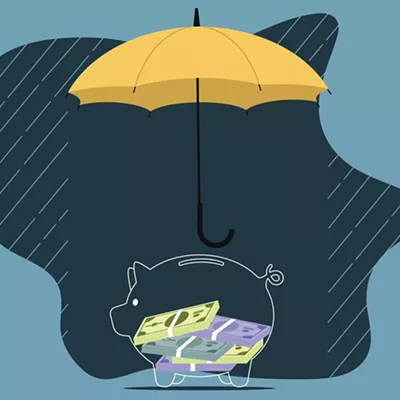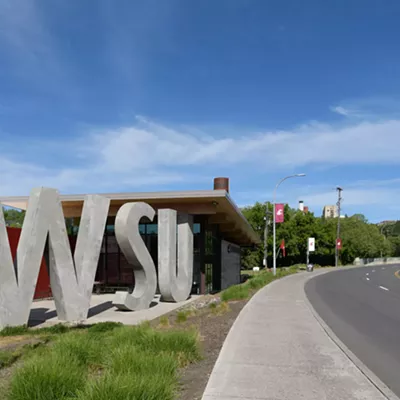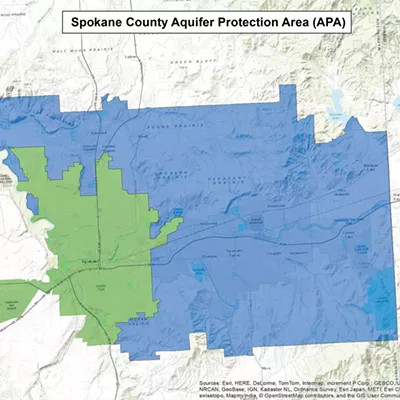The top of Doomsday Hill isn't the top of Doomsday Hill. And Doomsday isn't even the toughest hill on the Bloomsday course.
These and other startling revelations -- like the fact that you're really not in the kind of shape you should be for Sunday's little 7.46-mile jaunt over hill and dale -- are the result of talking to a guy like Rich Shine, who is an Engineering Technician for the City of Spokane, one of Bloomsday's finish-line volunteers and the Keeper of the Sacred Course Statistics.
From the T.J. Meenach Bridge up Doomsday (officially, North Pettet Drive) all the way to the right-hand turn onto Mission Avenue is just under three-quarters of a mile, says Shine. It's a 120-foot gain in elevation from the bridge to the Vulture at the so-called top of Doomsday, with an average uphill grade of 6.5 percent (meaning that for every 100 feet you advance horizontally, you're climbing six and a half feet). But what lots of people don't realize is that there's another 25-foot rise from the Vulture to Mission -- and then still another 12 feet of elevation to climb as you wend your way westward along Mission for one-third of a mile. The highest point on the entire course, in fact, comes up about 60 yards after runners make the southward turn onto Lindeke Street.
All told, then, the actual Doomsday Hill -- from Meenach Bridge to the peak on Lindeke -- isn't just six-tenths of a mile and a climb of 120 feet. Instead, it covers nearly 1.1 miles and burns your quadriceps with 157 feet in elevation gain (like climbing nearly sixteen flights of stairs).
From there, thankfully, it's downhill all the way on Lindeke and even as you turn for home on Broadway Avenue -- that is, until you reach Ash Street. The home stretch (610 yards from Ash to the finish line in front of the County Courthouse) is slightly uphill, baby. (Just one final test of your stamina.)
But let's go back earlier in the race and examine those other hills. Lots of Bloomies claim that Cemetery Hill is actually tougher than Doomsday.
The run-up (sorry) to Cemetery Hill is part of what makes it difficult. Tell us the facts, Mr. Wizard. First you cruise for a little over a mile from the starting line along Riverside Avenue and through Browne's Addition.
The course's first significant downhill: from the backside of the MAC to Latah Creek, half a mile downward at a 5.5 percent gradient. (You're feeling fine now, part of a thundering herd: Thousands of shoes are hitting the pavement extra-hard, in unison.)
From the Marne Bridge over Latah Creek and along Second and Pacific avenues up to Government Way: Just over one-third of a mile at a 4 percent grade (but there's a 700-foot section that rises at nearly 5 percent). This is where you start to feel it, and it's where you first see people starting to walk or, worse, bent over with hands on knees, retching.)
There's a nice sharp downhill section from Pacific and Government Way to the entrance of Riverside Cemetery (where the first of the water stations is located, marking the official beginning of Cemetery Hill). Rising 85 feet in six-tenths of a mile, Cemetery Hill averages less than a 3 percent grade. But nearly all that elevation gain (73 of the 85 feet) comes in the second half of Cemetery Hill (one-third of a mile at nearly 5 percent).
So if you compare the complex of hills from Latah Creek up Second, down Pacific, then up Government Way in the actual Cemetery Hill section (1.2 miles) to the Meenach-to-Vulture section of Doomsday (0.6 miles), it's clear that the earlier set of hills is nearly as steep and much longer.
And that's why some people think Cemetery Hill is worse than Doomsday.
Of course, try telling that to the runners who, having just crossed the five-mile mark, are staring up at the long, long expanse of North Pettet Drive.
Well, you're two-thirds of a Bloomie by then. Might as well kick it on home.
Publication date: 04/28/05
















